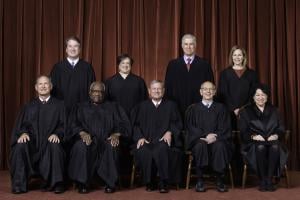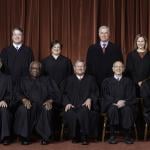
Seated from left to right: Samuel A. Alito Jr., Clarence Thomas, John G. Roberts, Jr., Stephen G. Breyer, Sonia Sotomayor. Standing from left to right: Brett M. Kavanaugh, Elena Kagan, Neil M. Gorsuch, Amy Coney Barrett.
CREDIT: Photograph by Fred Schilling
Justice Sotomayor’s Dissent
Yesterday, Supreme Court Justice Sonia Sotomayor slammed six of her Court colleagues for “rewarding lawlessness” regarding President Donald Trump. In a scathing 19-page dissent, joined by Elena Kagan and Ketanji Brown Jackson on an immigration case in which the Court overruled an appeals Court and thereby favored the government deporting illegal immigrants to foreign countries other than their own country of origin. The six justices whose majority ruled in the government’s favor did not provide any rationale for their decision, as if maybe there wasn’t any.
Sotomayor’s Allegation of Lawlessness
Justice Sotomayor said in her dissent, “The government’s assertion that these deportations could be reconciled with the injunction is wholly without merit. Given its conduct in these proceedings, the government’s posture resembles that of the arsonist who calls 911 to report fire fighters for violating a local noise ordinance.”
Sotomayer further denounced the ruling by alleging, “This is not the first time the court closes its eyes to noncompliance [to law], nor, I fear, will it be the last. Yet each time this court rewards noncompliance with discretionary relief, it further erodes respect for courts and for the rule of law.”
Justice Sotomajor also alleged in her statement, without mentioning the president, though it was obvious she had him in mind, “Once norms are broken, then you’re shaking some of the foundation of the rule of law.”
Trump’s Lawlessness Makes Him a Precursor of the Final Antichrist
I believe Donald Trump is laying a pathway for lawlessness that eventually will culminate in the future, final Antichrist rising to power, whom the apostle Paul calls twice “the lawless one” (1 Thessalonians 2.3, 9). Apparently, that was the normal title given to this man whom later Christians also called “the antichrist” (1 John 2.18).
Paul was addressing in this letter says a false notion that some Christians had, that Jesus had already returned from heaven to earth in fulfillment of the many biblical prophecies that he will indeed do that someday. But Paul writes, “As to the coming of our Lord Jesus Christ and our being gathered together to him, … that the day of the Lord is already here. Let no one deceive you in any way; for that day will not come unless the rebellion comes first and the lawless one is revealed, … whom the Lord Jesus will destroy with the breath of his mouth, annihilating him by the manifestation of his coming” (1 Thessalonians 2.1-3, 8).
Paul is not original in this prediction of the final Antichrist. Rather, he alludes to Daniel the prophet’s prophecy, “When the transgressions have reached their full measure, a king of bold countenance shall arise” (Daniel 8.23). Paul’s “rebellion” refers to Daniel’s “the transgressions,” and Paul’s “lawless one” refers to Daniel’s “king of bold countenance.”
So, what scripture teaches is that a rebellion against law will occur, and it will lay the pathway for the man of lawless, the final Antichrist, when he appears at the end of this age.












